In the quiet corner of a cozy kitchen, a bubbling jar of gluten-free sourdough starter sits patiently, alive with the promise of tasty homemade gluten-free sourdough bread. Sourdough is an ancient tradition that has been passed down through generations.
Are you ready to delve into gluten-free sourdough baking? Let’s get started by making your gluten-free sourdough starter!
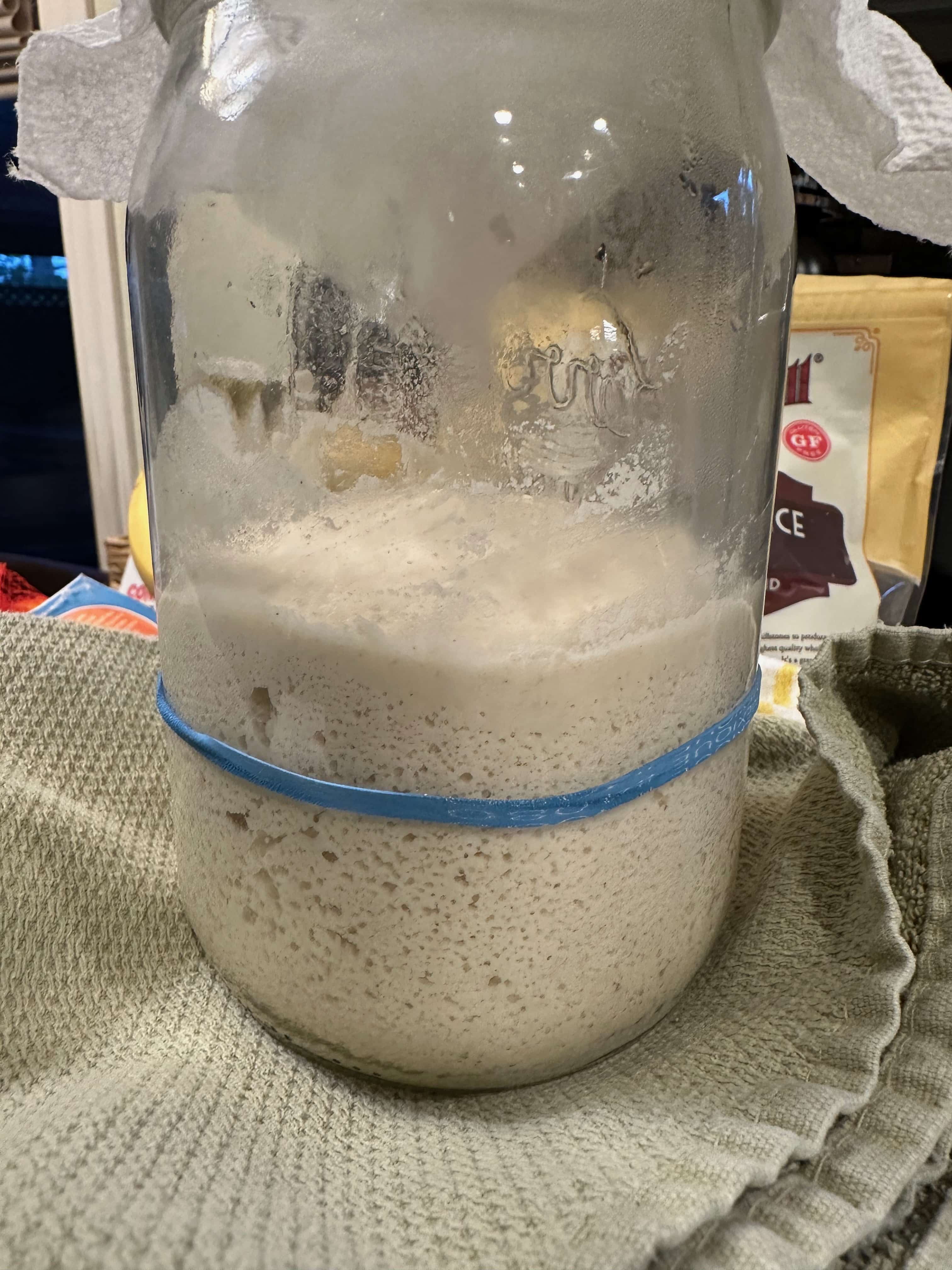
My original post on how to make gluten-free sourdough bread was so long that I felt it would be much easier and more helpful for everyone if I broke it down by writing up how to make the gluten-free starter information separately.
When I first interviewed Sadie at Bread Srsly, she was so generous to share an older version of her famous sourdough recipe with me to share with my readers. I have streamlined Sadie’s original recipe and tested a few different gluten free flours and blends to make it easier for you to recreate this recipe.
If you want to try Sadie’s original recipe given to me, you can use ¼ cup of millet flour or ¼ cup of sorghum flour. (Check out Rachel’s comment in my Gluten-Free Sourdough post to see her comments on how she uses the millet flour!)
I will cover all the steps needed to make a gluten-free sourdough starter with several different gluten-free flours and blends so you can compare and dive in to make your starter! Gluten free baking is like a chemistry project! Are you ready to get started?
Recipe At A Glance:
Allergen Information:
This starter is gluten-free, egg-free, dairy-free, nut-free, soy-free, and completely vegan.
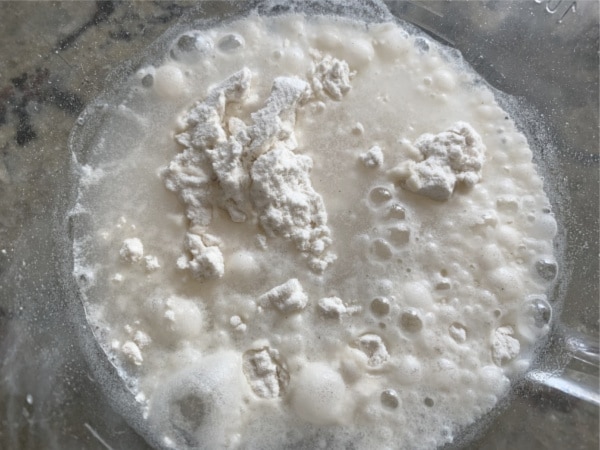
🔑 Sandi says: This article was written when I made my old sourdough starter. It didn’t survive after a long vacation a few years ago, and I started my new starter using a pre-made sourdough starter. I found this Gluten Free Sourdough Starter from Cultures for Health quite amazing. My starter took off in a big way. I fed it brown rice flour and it was doubling in size by day 4!!! If you want to jump-start the process, I can’t say enough good about using this sourdough yeast.
Start with the right tools; read My Favorite Sourdough Tools for a full list of equipment.
Sourdough Starter Prep Instructions:
Why Water Quality Is Important:
I always use purified water when making sourdough or baking with yeast. Chlorine and chemicals in our tap water can kill your yeast and inhibit the rise. If you want the best rise, you must use purified water that doesn’t contain these chemicals.
Day 1:
- Mix together equal parts of a gluten free flour blend and water in a clean bowl or quart-sized mason jar. I used a ¼ cup flour to ¼ cup water ratio. If your gluten free flour blend is starchy, you will want to use a little more water. You want the starter to have the consistency of a slightly thick pancake batter. Stay away from using pure starch sources such as tapioca and potato.
- Leave the starter in a bowl or mason jar at room temperature. Cover the bowl with a towel. See FAQ for cold season tips. If your house is cold or winter, you must take steps to keep your starter warm.
- You can use Bob’s Red Mill 1 to 1 GF Blend , King Arthur Measure for Measure GF Blend., GF Jules Gluten Free Flour Blend, or individual flour like brown rice, millet, or sorghum. I find brown rice flour starters perform much faster than a blend.
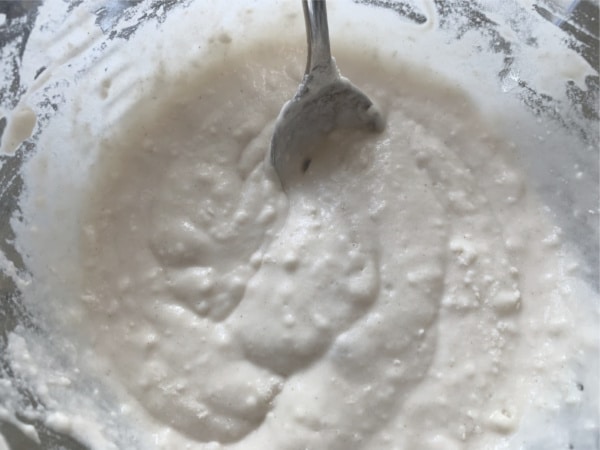
Day 2:
Feed the starter 2-3 times a day. I use 1 TBSP of flour to 1 TBSP of water, a 1:1 or a 1:2 ratio, depending on which blend you use. Again, be sure to use filtered water and stir the starter well. I keep my starter in my kitchen bay window in warmer months, but I ensure a clean kitchen towel covers it so no sunlight gets in.
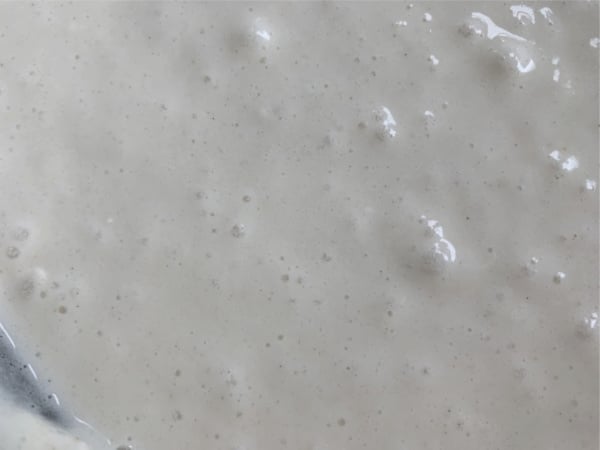
🔑 Sandi says: If you see clear liquid on top of your starter, this is called hooch. This means you need to feed your starter. See the Recipe FAQ for more details on hooch. You will want to drain off that liquid before feeding the starter.
Days 3-4:
After 3-5 days, your mixture should start to smell sour and have bubbles. Congratulations! You are almost there.
If your bowl or jar starts to get full, feel free to discard some of the starter. In Sadie’s original recipe, she didn’t write about discarding any of her starter. Taking some discard out of your starter before feeding is good because it helps your bacteria become stronger.
You can use the discard to make these Gluten-Free Discard Crackers or these Gluten-Free Sourdough Discard Biscuits if you choose to discard. We also love these Gluten-Free Sourdough Discard Muffins.
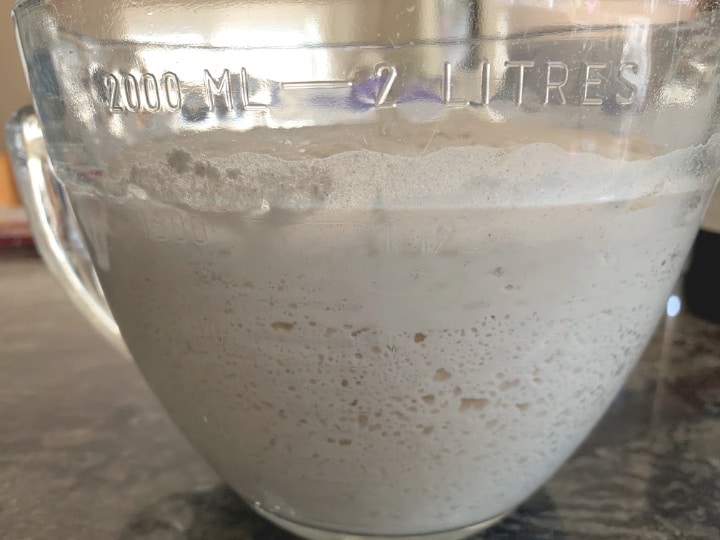
Day 5:
This is what my starter looks like now! It is thick and creamy looking with lots of little bubbles. It still has the consistency of pancake batter.
Use this sourdough gluten free starter to make this homemade Gluten Free Sourdough Boule.
How To Store Your Gluten-Free Sourdough Starter:
If you love sourdough bread and want to continue making it regularly, your best bet is to keep your starter in the refrigerator unless you use it frequently during the week. The starter will still need to be fed to survive. The refrigerator’s cold slows the fermentation process, and it sort of puts your starter to sleep. I do not recommend storing your starter in the fridge until it is at least 3-4 weeks old; even older is definitely better.
A good guide to know if your starter is old enough to be refrigerated is whether your starter doubles within 2-4 hours of feeding it; it is ready to go into the refrigerator.
- Do not store your sourdough starter in a metal container. Store in a glass or ceramic container. I store mine in a quart-sized mason jar. (These are my favorite because they have plastic lids!)
- You will want to discard, then take out some discard before feeding the starter. The amount of discard depends on how much starter you have. If my jar has ½ cup total starter, I would discard 3 TBSP. (I keep discard in a separate container to use it in gluten free discard recipes.) Fed the starter before putting it in the fridge.
- If the starter is on the younger side, feed it in the refrigerator every 4-5 days. As the sourdough starter ages, you can feed it less often, once every 1 ½ to 2 weeks. I feed mine by adding 2 TBSP of flour to 2 TBSP of purified water. Stir it well so the flour is incorporated in. If your blend is starchy, you can use 3 tablespoons of water.
- Cover it with the lid and place it in the refrigerator.
When you want to bake with your starter, take the starter from the refrigerator the night before. Feed it (2 tablespoons flour and 3 tablespoons of purified water) and cover it completely with a clean kitchen towel. Again, see the Recipe FAQ if it is cold in your house or winter.
You can use some of your starter to bake sourdough the next day, then discard it, feed it, and put it back in the refrigerator.
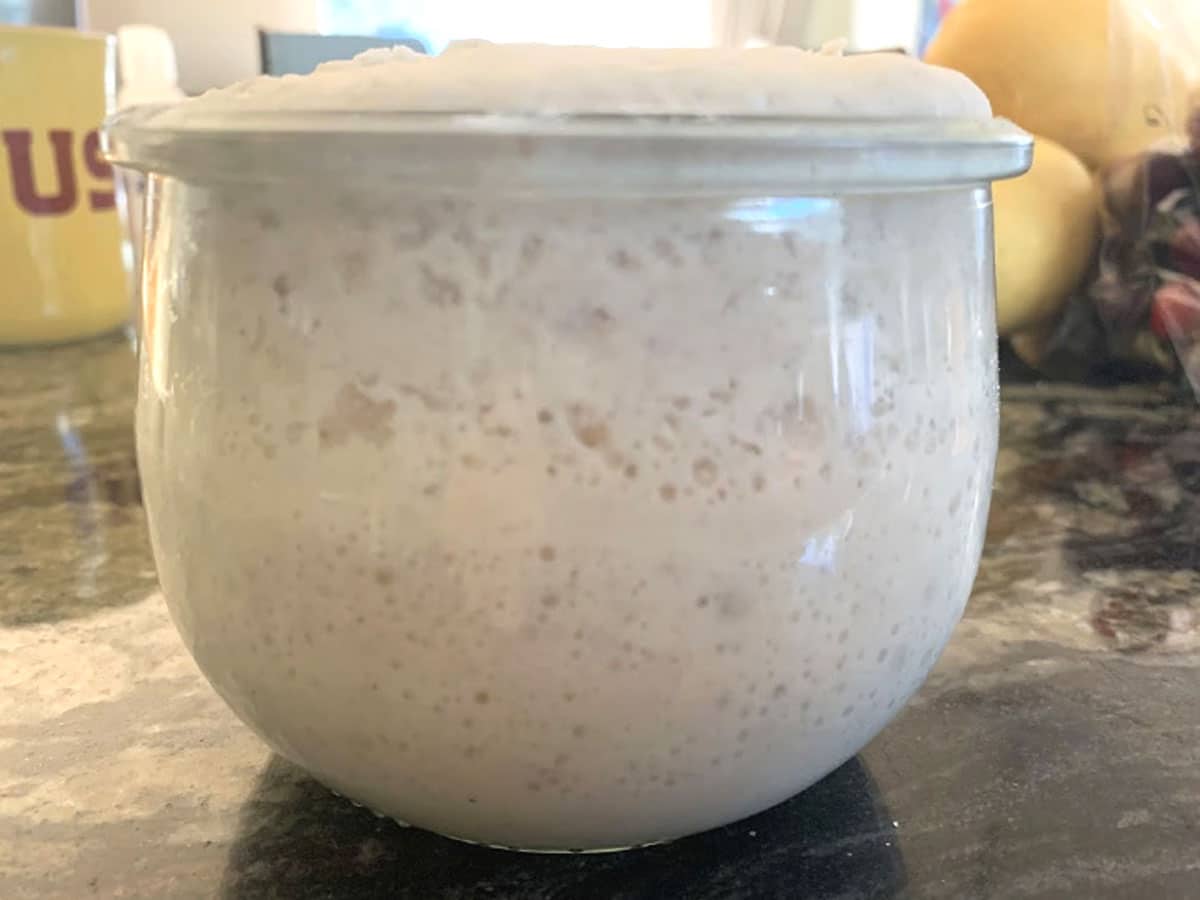
My daughter named our starter Winifred, or “Freddie” for short. It is a tradition to name your sourdough starter. What will you name your starter?
📢 Sandi says: Do not pour starter or clean starter containers with starter residue in the sink!!! Sourdough starter can be like cement. If you use a spoon to stir the sourdough after feeding, use a paper towel to wipe the spoon off first. If you are changing to a clean jar, fill the jar with water and use that to water plants outside. The starter is good for plants, but not good for your kitchen pipes!
Frequently Asked Questions:
My opinion has changed over time. I exclusively use brown rice flour now for making and feeding my starters. It is cheaper to use than a 1:1 blend, and it activates and stays active much better because there is no starch or gum to slow the fermentation down.
Yes, you can switch flour types. Fermentation may slow for a day or two, depending on whether you use a blend or single-grain flour, but it will pick up again!
When I moved from a 1:1 blend to brown rice flour, my starter exploded and almost overflowed over the sides of my jar. It tripled in size. I plan to use some discard to make Gluten Free Sourdough Pizza tonight with it.
There are definite benefits to discarding some of the starter as it makes the bacteria in your starter a lot stronger. If you use the starter to make bread or other recipes several times a week, I find you don’t have to discard some because you are using it often. If you only use the starter once, or a week or less, discarding it is a good idea.
If your sourdough starter has been exposed to bacteria, it can go bad. The easiest way to tell if your starter is still good is to open it and smell it before each use. Also, look at the starter to make sure it is still bubbling.
If it smells like unbaked bread, it is still good and can be baked. If you notice a foul odor, mold growing, or a pink or orange tint, it hasn’t gone well and should be discarded.
The liquid that forms on top of your sourdough starter is known as “hooch.” When you see hooch in your starter, that indicates that the sourdough needs to be fed; the development of hooch is perfectly normal and not a cause for concern.
Simply drain off the hooch before you feed the sourdough starter. You may notice the hooch smells like alcohol, which is also expected. (See the photo below of hooch!)
Yes, you can freeze the sourdough starter. If you freeze the starter, you will not have to feed it. When you are ready to bake the bread, you must give the sourdough starter a week before the dough is active again. You must begin the feeding process once you remove it from the freezer.
Freezing the starter is an excellent idea if you don’t have the time and effort to keep feeding it. I recommend freezing.
When I first wrote this post, I created my starter in the summer when it was warm. Keeping a starter warm in the colder months is a challenge! Some people store it in their oven or microwave oven with the oven light on. This provides some heat. Heat is important, especially when you are trying to get a starter going!
I made my current sourdough starter in the winter months. I store mine on the base of a Euro Cuisine Yogurt Maker my mother-in-law gave me. I have two dish towels folded under my jar to keep the starter from getting too hot.
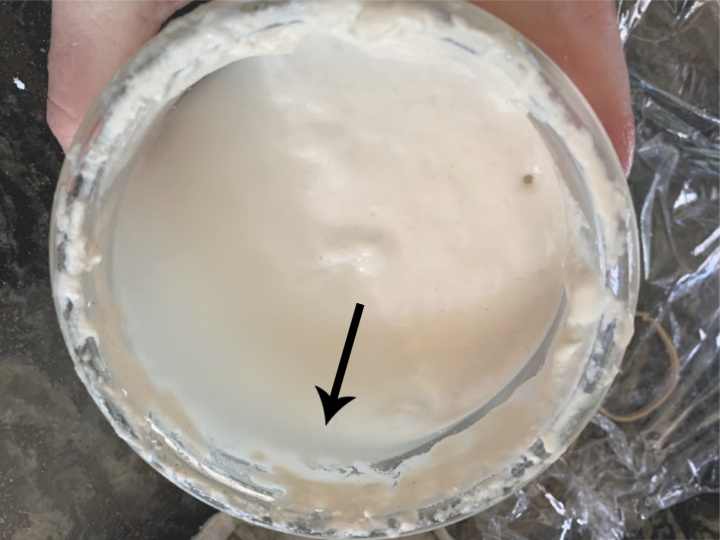
This sourdough starter, aka levain, is popular in my Gluten Free Crescent Rolls recipe. Don’t forget to check out the next step…making the sourdough bread!
Gluten-Free Sourdough Recipes To Try:
- This sourdough starter, aka levain, is used in my Gluten-Free Crescent Rolls recipe.
- Don’t forget to check out the next step…making the Gluten-Free Sourdough Bread! This recipe makes a sandwich-style loaf using 1:1 gluten-free flour blends!
- My new favorite is this rustic Gluten Free Cranberry Walnut Sourdough Bread recipe.
Love This Recipe?
If you made and enjoyed this recipe, I would be incredibly grateful if you could leave a comment below. Please include which flour blend you used. This will help others know this recipe is delicious. Thank you!
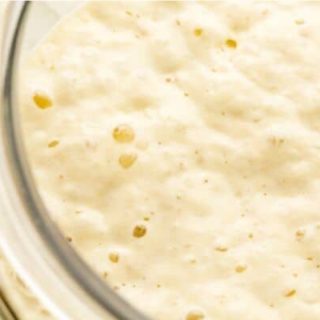
How to Make a Gluten Free Sourdough Starter
Ingredients
- ¼ cup gluten free flour * see note
- ½ cup purified water * see note
Instructions
- Making a gluten-free sourdough starter is chemistry. This is one recipe wehre it is IMPORTANT to read my whole recipe post, not just the recipe card. It is full of tips and tricks that would be too lengthy to add here.
Day 1
- Mix together equal parts of a gluten free flour blend and water in a clean bowl or quart-sized mason jar. I used a ¼ cup flour to ¼ cup water ratio. If your gluten free flour blend is starchy, you will want to use a little more water. You want the starter to have the consistency of a slightly thick pancake batter. Stay away from using pure starch sources such as tapioca and potato.
- NOTE: I highly recommend using filtered or bottled water. Chlorine and chemicals will kill the beneficial bacteria you are trying to grow.
- Leave the starter in a bowl or mason jar at room temperature. Cover the bowl with a towel. See FAQ for cold season tips. If your house is cold or winter, you must take steps to keep your starter warm.
Day 2
- Feed the starter 2-3 times a day. I use 1 TBSP of flour to 1 TBSP of water, a 1:1 or a 1:2 ratio, depending on which blend you use. Again, be sure to use filtered water and stir the starter well. I keep my starter in my kitchen bay window in warmer months, but I ensure a clean kitchen towel covers it so no sunlight gets in.
Day 3-5
- After 3-5 days, your mixture should start to smell sour and have bubbles. Congratulations! You are almost there.
- If your bowl or jar starts to get full, feel free to discard some of the starter. In Sadie's original recipe, she didn't write about discarding any of her starter. I do take out some disard because it helps your bacteria become stronger.
Notes
- I have used sorghum, brown rice, and millet flours successfully. I also have used King Arthur Measure for Measure GF Blend, Bob’s Red Mill 1 to 1 GF Blend, and GF Jules gluten free flour blends to make a successful starter.
- I found my starter really likes brown rice flour and it bubbles really well using it.
- In order to give your natural yeast a chance, I highly recommend using purified water. Chlorine in tap water can kill your yeast, making your starter not grow.
- I include very detailed instructions how to store your sourdough starter in my article. Please refer back to that because it has a lot of important information.
- I include a very detailed troubleshooting section in my article. If your starter is having some trouble, please refer to the Recipe FAQ in the article.
SPECIAL NOTE
Please know that every gluten free flour blend has a different starch to grain ratio. If you use a blend I didn’t test, you may need to adjust your moisture levels in your baked goods.
Nutrition
Nutrition Disclaimer
Nutritional information is an estimate provided to you as a courtesy. You should calculate the actual nutritional information with the products and brands you are using with your preferred nutritional calculator.


Hi Sandi,
I have been feeding my starter twice a day for 4 days and it is not getting bubbly looking. I have been adding 1:2 flour: purified water twice a day. I’m using King Arthur measure for measure gf flour. What does the temperature need to be in the room? I don’t have mine in a window because it is too cold. I had it sitting granite and the glass bowl feels cold. So I moved it over to the table that is close to the heat duct. Our house is 68 during the day and I drop it too 64 during the night. I’m thinking it’s not warm enough. A heat pad? Do I need to start over ?
Hi Lisa, I worry it is too cold right now for a starter to take. I have never started a starter in the winter, but there is an incredible gluten free sourdough Facebook group. I would recommend joining that group to get specific help for your question.
Ok thank you Sandi I will do that
How do you store your starter and where?
Hi Meghan, if I am actively growing it or warming it after being in the refrigerator, I let it sit on the counter. Otherwise I store it in the refrigerator and feed it every 2-3 days. I store in a mason jar with a lid in the refrigerator.
Which brown rice flour did you use? I want to make a starter and was interested in just using the brown rice flour. Will I need to add anything such as a startch to the brown rice flour?
Hi Sarah, I have used both Bob’s Red Mill GF Brown Rice Flour and Authentic Foods Brown Rice Flour in the past.
So my original starter is big. Do I discard it after making my first load and save some of the batter from that loaf? Or do I keep some of my initial starter and put it in the fridge?
Hi Kara, if your starter is large, use the discard to make a discard recipe like my sourdough discard crackers.
Hi there!
Question – so I’ve been working on my sourdough starter. I used Cup4cup and was doing equal parts flour and water. On Day 4, it looked like the dough was sort of congealed – thick and not watery or bubbling at all. Am I doing something wrong? I’ve tried changing to 1:2 ratio of flor to water but I’m wondering if I just need to start over? Also I’m using a bowl, not a jar….does that matter? Thank you for your feedback!
Hi Sheryl, I haven’t tested that flour, but I know it has dry milk powder. I wonder if that is causing your issues.
I’m on day 3 of feeding the starter. Do I count the day I started it as day 1 or the next day day 1?
When do I stop feeding it? Is it day 3 or day 5?
On day 5 do I let it sit or feed it and then use the bread recipe?
Hi Tiffany, I would count the first day and you will want to feed it for 5 days then if it is bubbling nicely, make bread. In the winter, it can take a little longer if you don’t keep it warm.
Cup4Cup is a starch heavy blend (it’s first ingredient is corn starch). I think that might be the issue here. Try using a blend that is not starch heavy or even just using brown rice flour. I think you will have success at that point.
I also wonder about the dried milk powder and how that affects things.
Has anyone tried this with coconut flour, Almond flour or buckwheat flour? My daughter is not only gluten intolerant but also wheat and grain intolerant so I’m hoping to find some kind of bread and cracker we can make with those.
Hi Amanda, I haven’t heard of using coconut flour. There is a great gluten free sourdough facebook group and I would recommend asking there.
I’m on day 3 of feeding and it’s not really bubbly. Do i need to do something else?
Hi Amy, to troubleshoot, I need more information. What gluten free flour are you using? Are you using purified water? Where are you leaving/storing the jar of starter? What is the temperature?
I just did the day 1 /2 c water, 1/4c gf brown rice flour. So for the next 3-5 days I will add 2tbsp flour and 1/4 c water. When it’s bubbly and sour I the. Add 2 c gf flour blend (lime Bob’s 1:1) 1 tsp Kosher salt and 1/2c of the starter (water to feel) … mix well and let rise 12-24 hours *is this in the mason jar? And the end result is the “starter” that I will keep and can make sourdough bread with? Continue to the bread recipe from here? And how do I keep and store the remaining starter?
Thanks for your help!
A first time sourdough starter gal!
Hi Li. So you would add the 2 c flour to a bowl. Let rise and bubble 12-24 hours. This is the starter. I take from this and put that starter into a mason jar. You need to feed it daily if you keep it on the counter, or 3x a week if it is in the refrigerator. You can make your first loaf of bread from the batch in the bowl. I hope this helps explain it a bit better. Welcome!
Hi, so I’m about to follow this and it will be my first time making my own stater ever of any kind. The step you mentioned feeding 3x a day how many days do I do that for. And after that I assume it will be ready to be used to making baked goods. Do you have to discard any? When and how? And can the discard be used or toss it. TIA
Hi Nikki, Some do discard, I do sometimes, but it isn’t necessary. (I do have a great gluten free cracker recipe made with discard if you do.) I mention in the post to feed 2-3 times per day. I usually do feed only twice. You can use the starter by day 5.
I am using the King Arthur brand, distilled water, and on my counter. I put it on my stove top yesterday since it was warm from baking.
This morning it was separated. I fed again and mixed it up not sure of it is still going to work.
Hi Amy, It sounds like it isn’t doing well if separated. What does it smell like?
Which GF flour is your favorite to make sourdough bread?
I’m hoping to make the starter tomorrow after going to the store
Hi Jodi, I tend to use Jules GF blend or King Arthur Measure For Measure. I know the King Arthur bag says not to use for yeasted recipes, but I get great luck with it.
I have an 150 year old sour dough yeast starter from a family friend. I would like to start a gluten free sour dough starter. In your version, are you adding a yeast or just hoping to have some wild yeast in the air settle into the culture?
Hi Joanna, Wow, I am impressed you have such an old starter. I do not add yeast and I cover my starter with a clean cloth…I am not sure how to answer your question as I am not familiar with the concept of wild yeast settling into the culture.
What do you do with the first mixture of water and flour that you have been feeding for 3-5 days? In your post, you say to take 1/2 cup from this and add to 2 cups of flour, add water to feel and let this rise for 12-24 hours. This becomes your starter. So what do you do with the remaining bubbly mixture? Throw it away? Is this not your starter?
I typically use the remaining mixture to bake something and then keep and save the smaller amount (starter) to keep.
My gf starter more than doubled by day 3, overflowing the jar and spraying everywhere! I have been making regular sourdough for a few months now. Is it possible that my non-gf starter yeast found its way into my gf starter? How else to explain such rapid growth? I used Krusteaz all purpose gf flour.
Is it ok to try using this starter after only 3 days, or am I asking for a failed loaf?
Hi Kevin, I haven’t used Krusteaz. I am wondering if it has a higher starch content, which is feeding the yeast quicker? I haven’t experienced this, so I am not sure how to guide you on baking at day 3. Can you please keep me posted?
Finally got a batch that’s looking good! Switched from Reds 1:1 to King Arthur M4M. Starter about doubled 5th day, started the 1st bread recipe, waiting 12-24 hrs.
I still have at least ½ cup of starter after I used ½ cup in bread mix. Why not use this to continue feeding, rather than pulling ½ cup from the bread mix? Or does it matter?
That is awesome! It probably doesn’t matter because it isn’t a large amount.
Once the start is made, how do you store it?
Hi Douglas, thanks for asking. If you plan to use this starter often, store on the counter and feed it 2x a day. If you only plan to make 1-2 loaves a week, you can store it in the refrigerator and just take it out the night before you use it (feed it and let it sit out overnight.)
Hi!
So just to clarify…after the 12 hr rise…then you take 1/2 cup out and that is the “reserve starter”?
Also if I understand this correctly…once you add the flour/water/starter mentioned at the end…this is also the start of making the actual bread recipe right?
Thanks!
That is correct Charlotte.
I’m just starting the starter, am confused. You start with ¼c flour and water, add 1 tbs flour and 2 tbs water twice a day for 3-5 days, so you have about a cup or so on day 5.
Then you say add to bread mix on day 5 to make the “real starter” . So now have 3 or 4 cups of starter? It’s like your making starter twice, then you use ½c to make your bread. So you can store the other 2 or 3 cups that are left? But you say store ¼c in fridge. Confused between where starter ends and bread begins. Thanks!
Hi. Thanks for asking. That real starter is what you make your first loaf from. Take 1/2 cup out after adding the bread mixture. That is your new starter and the rest you use to make the bread.
One other question. Day one starts out:
“Day One: Mix together equal parts of a gluten free flour blend and water. I used 1/4 cup flour to 1/2 cup water ratio”
“Equal parts”, is not ¼:½. All the rest is the ¼:½ ratio.
I’m on day 3 doesn’t seem to be riding, but is bubbling a little.
This is going to depend on your flour blend. If it is starchy, you will do better if the mix is more watery. If you use single flours, 1:1 is often better. I will go in and try to clarify in the post more. Thank you.
Hi, looking forward to starting this process. About this part of the recipe
Add your starter to the bread mix:
2 cups gluten free flour blend (*see note)
1 1/2 tsp Kosher salt
1/2 c sourdough starter (see post for directions to make this)
water by feel
Mix well and set out to rise for 12-24 hours. Congratulations! This is your starter. See my gluten free sourdough bread recipe linked in this article for the bread recipe to use your starter with.
Is the ‘bread mix’ you refer to a bread recipe, or a second phase of the starter that then gets added to a bread recipe?
Thanks!
Hi Julie, Yes, the bread mix is the recipe in the recipe card at the bottom. You only have to do this once, then make sure to save 1/2 cup of the new starter for a new loaf.
Still confused. I’m on day 6, finally bubbling and rising! Have about 1-1.5 cups of starter. Do I use ½c of this to make bread, and save ½c of it? Or do I use ½c, make the bread recipe, rise for 12-24hrs, and call this the starter? Use ½c of this for bread and save ½c of this, and throw out the rest of this 1st bread recipe?
I am so glad you are getting bubbles :-). Use 1/2 cup to make bread and the rest can be used as starter to keep feeding etc. Many will discard some at this point. I have pizza loving kids so I usually make a loaf and a big pizza, then put the remaining 1/2 in a clean mason jar and feed it to keep it going as my starter.
Have you tried Cup4Cup gluten-free multipurpose flour, and if so did it turn out well?
Hi Dina, I scanned all comments on both the starter and the bread post, then looked at a post in the gluten free sourdough FB group and Charlene did use Cup4Cup. I am pasting her comments here for you just in case you are not in that group.
“Used Only Cup4Cup Flour blend for every step including bread making. Why? We have had good experiences using this blend and it is affordable especially during these unprecedented times. After much research could not find any info regarding Cup4Cup so thought to try making a sourdough start and bread with it. Pleasantly surprised!
Disclaimer: I am NOT a professional baker or scientist
Start
3:00 pm Make a start 1/4 cup flour and distilled water in mason jar. Covered with plastic wrap.
Day 1
11:30 am Did not discard. Add 1/3 cup flour and water. Cover with dishcloth instead of plastic wrap to see if that helps.
9:00 pm it’s doubled in size. Discard some and feed it 1/3 cup flour and water.
Day 2
9:30 am starter doubles in size! Discard and feed 1/3 cup flour and water. Rise a little in day.
5pm discard and keep and feed 1/3 cup flour and water
Day 3
AM Rise about 30% more. Let it sit all day. By evening it rose and had lots of big air gaps
6:45 pm discard and feed 1/2 cup flour and water
11:30 pm start has already risen 50%
Day 4
8:45 am start has doubled and lots of bubbles and smells sour. Decide to try making bread with it. Keep some for start and use about 1/2 cup of start to make bread (according to recipe)
9:00 am make batter for sourdough bread and let it rise all day
Here is what I did:
(This is not a Gluten free recipe)
2 cups GF flour blend
1 1/2 tsp kosher salt
1 1/2 tsp sugar (helps for a faster rise)
1/2 cup sourdough starter
1 1/4 cup water (add enough to make a medium thick pancake batter)
-put dry ingredients into bowl and whisk together
-add water and sourdough start
-you want a dough that is wet like a pancake batter
-pour batter into a greased loaf pan to rise
-let dough rise for 12 to 24 hours at room temperature or until batter rises to top of pan
-heat oven to 450
-put loaf into oven and decrease oven to 420 for 20 minutes
-decrease oven to 375 for 30 minutes
-bread should be around temperature 205
-let cool completely before slicing
Adapted from this recipe:
https://www.fearlessdining.com/chef-recipe-bread-srslys…/
8:35 pm it had risen to top of pan
Heat oven to 450, then turn down to 420 and bake for 20 minutes. Change to 380 for another 25 minutes.
Loaf shrunk. Crispy and moist on inside. Hard outer crust. Yummy”
Hi! Is it beneficial to use a bowl vs say a quart sized Mason jar? Does is make a difference or maybe make the original starter in a bowl and then switch to a Mason jar for keeping in the refrigerator?
I don’t see any issues with using a bowl, just make sure it is very clean and use only purified water.
“Day One: Mix together equal parts of a gluten free flour blend and water. I used 1/4 cup flour to 1/2 cup water ratio”
1/4 cup flour & 1/2 cup water is a 1:2 ratio, not equal parts. What am I missing?
Hi Beth, Thanks for your note. It really goes by what Sadie calls water feel. Some gluten free flours absorb more water than others. Please use enough water so your starter has the consistency of pancake batter.
Hi! I am about to try a gluten free sourdough starter for the first time and read one recipe that suggested brown rice flour as the starter flour. They mentioned the 1 to 1 flours giving a grossly sour smell. But! I want my sourdough to be very sour. Is there a flour you would recommend to get a more sour starter or would you just keep it going for longer? Would you recommend the Bobs 1 to 1 over brown rice flour? Thank you <3
Hi Elise. I have had luck with flour blends and didn’t notice a stronger sour smell than with rice flour. I think a stronger sour smell can often be a “hungry starter” at least I notice this if I forget to feed it. I have used Bob’s 1 to 1, as have several commentors. I am currently using rice flour in my starter, but just ran out and will probably feed it a blend until a new bag of rice flour arrives.
I had the same question and decided to use what was in the boxed area of the recipe.